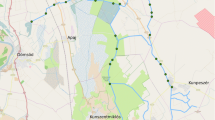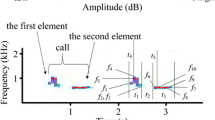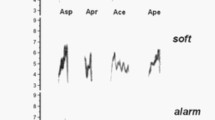Abstract
Vocal individuality varies between species and/or ontogenesis stages depending on needs in the vocal recognition, but also estimation of individual differences depends on the method of analysis. We studied pair-specific differences of duets elicited by mating pairs of Siberian crane Grus leucogeranus. We quantitatively described the duet structure and compared visual and statistical classification methods of pair identification by duet. Three methods were used: discriminant analysis, method of classification trees and visual classification of spectrogram. We found significant interpair differences. The pairs differ by duet structure that is by the ratio of male- and female-initiated duets and by the ratio of the number of male to female calls; temporal-frequency duet characteristics are pair-specific, too. All methods showed high interpair differences, which exceeded random values significantly. Discriminant analysis stepwise procedure based on 11 parameters resulted in 97.3% of correctly assigned duets. Human observers correctly assigned 80.7% of spectrograms. Our data provide a basis for remote monitoring of this endangered species with a wild population of only 3,000 birds.



Similar content being viewed by others
References
Archibald GW (1976a) The unison call of cranes as a useful taxonomic tool. Dissertation, Cornell University
Archibald GW (1976b) Crane taxonomy as revealed by the unison call. In: Lewis JC (ed) Proceedings of the International Crane Workshop. ICF, Baraboo, pp 225–251
Aubin T, Jouventin P (2002) How to identify vocally a kin in a crowd? The penguin model. Adv Study Behav 31:243–277
Aubin T, Jouventin P, Hildebrand C (2000) Penguins use the two-voice theory to recognise each other. Proc R Soc Lond B 267:1081–1087
Bragina EV, Beme IR (2007) Sex and individual variability in the vocal repertoire of adult Siberian crane (Grus leucogeranus, Gruidae). Zool Zh 86:1468–1481, In Russian
Briefer E, Aubin T, Lehongre K, Rybak F (2008a) How to identify dear-enemies: the group signature in the complex song of the skylark Alauda arvensis. J Exp Biol 211:317–326
Briefer E, Rybak F, Aubin T (2008b) When to be a dear-enemy: flexible acoustic relationships of neighbouring skylarks Alauda arvensis. Anim Behav 76:1319–1325
Brunton DH, Evans B, Cope T, Ji W (2008) A test of the dear enemy hypothesis in female New Zealand bellbirds (Anthornis melanura): female neighbors as threats. Behav Ecol 19:791–798. doi:10.1093/beheco/arn027
Budde C (2001) Individual features in the calls of the Grey Crowned Crane, Balearica regulorum gibbericeps. Ostrich 72:134–139
Charrier I, Jouventin P, Mathevon N, Aubin T (2001a) Individual identity coding depends on call type in the South Polar skua Catharacta maccormicki. Polar Biol 24:378–382. doi:10.1007/s003000100231
Charrier I, Mathevon N, Jouventin P, Aubin T (2001b) Acoustic communication in a black-headed gull colony: how do chicks identify their parents? Ethology 107:961–974
Charrier I, Mathevon N, Jouventin P (2003) Fur seal mothers memorize subsequent versions of developing pup’s calls: adaptation to long-term recognition or evolutionary by-product? Biol J Linn Soc 80:305–312. doi:0.1046/j.1095-8312.2003.00239.x
Claperton BK (1987) Individual recognition by voice in the pukeko, Porphyrio porphyrio melanotus. NZ J Zool 14:11–18
Curé C, Aubin T, Mathevon N (2009) Acoustic divergence between two sympatric nocturnal burrowing petrels: the Yelkouan and the Cory’s shearwaters. Biol J Linn Soc 96:115–134
Degtyarev AG, Labutin YV (1999) About breeding of white crane Grus leucogeranus (Gruiformes, Gruidae) in Yakutia. Zool Zh 78:1210–1217, In Russian
Delport W, Kemp AC, Ferguson JWH (2002) Vocal identification of individual African Wood Owls Strix woodfordii: a technique to monitor long-term adult turnover and residency. Ibis 144:30–39. doi:10.1046/j.0019-1019.2001.00019.x
Falls JB (1982) Individual recognition by sounds in birds. In: Krodsma DH, Miller EH (eds) Acoustic communication in birds, vol 2. Academic, New York, pp 237–278
Farabaugh SM (1982) The ecological and social significance of duetting. In: Krodsma DH, Miller EH (eds) Acoustic communication in birds, vol 2. Academic, New York, pp 85–124
Feldesman M (2002) Classification trees as an alternative to linear discriminant analysis. Am J Phys Anthropol 119:257–275
Fisher J (1954) Evolution and bird sociality. In: Huxley J, Hardy AC, Ford EB (eds) Evolution as a process. Allen and Unwin, London, pp 71–83
Flint VE (1987) Siberian crane. In: Birds of USSR. Leningrad, Nauka, pp 313-326 In Russian
Galeotti P, Sacchi R (2001) Turnover of territorial Scops Owls Otus scops as estimated by spectrographic analyses of male hoots. J Avian Biol 32:256–262
Germogenov NI, Pshennikov AE, Kanai Yu (2009) On territorial conservatism of Siberian crane (Grus leucogeranus). Zool Zh 88:860–870, In Russian
Gilbert G, Tyler GA, Smith KW (2002) Local annual survival of booming male Great Bittern Botaurus stellaris in Britain, in the period 1990–1999. Ibis 144:51–61. doi:10.1046/j.0019-1019.2001.00012.x
Godard R (1991) Long term memory of individual neighbours in a migratory songbird. Nature 350:228–229
Grava T, Mathevon N, Place E, Bailluet P (2008) Individual acoustic monitoring of the European Eagle Owl Bubo bubo. Ibis 160:279–287
Hall ML (2004) A review of hypotheses for the functions of avian duetting. Behav Ecol Sociobiol 55:415–430. doi:10.1007/s00265-003-0741-x
Hall ML, Magrath RD (2000) Duetting and mate-guarding in Australian magpie-larks (Grallina cyanoleuca). Behav Ecol Sociobiol 47:180–187
Hardouin LA, Tabel P, Bretagnolle V (2006) Neighbour–stranger discrimination in the little owl, Athene noctua. Anim Behav 72:105–112. doi:10.1016/j.anbehav.2005.09.020
Hayes MA (2005) Divorce and extra-pair paternity as alternative mating strategies in monogamous sandhill cranes. MSc thesis, The University of South Dakota
Janik VM (1999) Pitfalls in the categorization of behaviour: a comparison of dolphin whistle classification methods. Anim Behav 57:133–143
Jouventin P, Aubin T (2002) Acoustic systems are adapted to breeding ecologies: individual recognition in nesting penguins. Anim Behav 64:747–757
Jouventin P, Aubin T, Lengagne T (1999) Finding a parent in a king penguin colony: the acoustic system of individual recognition. Anim Behav 57:1175–1183
Klenova AV, Volodin IA, Volodina EV (2008) The duet structure provides information about pair identity in the red-crowned crane (Grus japonensis). J Ethol 26:317–325. doi:10.1007/s10164-007-0063-y
Lengagne T, Lauga J, Aubin T (2001) Intra-syllabic acoustic signatures used by the king penguin in parent-chick recognition: an experimental approach. J Exp Biol 204:663–672
Lessells CM, Rowe CL, McGregor PK (1995) Individual and sex differences in the provisioning calls of European bee-eaters. Anim Behav 49:244–247
Littlefield CD (1981) Mate-swapping of sandhill cranes. J Field Ornithol 52:244–245
Mathevon N (1997) Individuality of contact calls in the Greater Flamingo Phoenicopterus ruber and the problem of background noise in a colony. Ibis 139:513–517
Mathevon N, Charrier I, Jouventin P (2003) Potential of individual recognition in acoustic signals: a comparative study of two gulls with different nesting patterns. CR Biol 326:329–337
Mays HL, Yao CT, Yuan HW (2006) Antiphonal duetting in Steere’s liocichla (Liocichla steerii): male song individuality and correlation between habitat and duetting behavior. Ecol Res 21:311–314. doi:10.1007/s11284-005-0115-0
McCowan B (1995) A new quantitative technique for categorising whistles using simulated signals and whistles from captive bottlenose dolphins (Delphinidae Tursiops truncatus). Ethology 100:177–193
Meine C, Archibald GW (1996) The cranes: Status Survey and Conservation Action Plan. IUCN, Gland, 294 pp
Nesbitt SA (1989) The significance of mate loss in Florida Sandhill Cranes. Wilson Bull 101:648–651
Peake TM, McGregor PK (2001) Corncrake Crex crex census estimates: a conservation application of vocal individuality. Anim Biodivers Conserv 24:81–90
Reby D, Joachim J, Lauga J, Lek S, Aulagnier S (1998) Individuality in the groans of fallow deer (Dama dama) bucks. J Zool 245:79–84
Reby D, André-Obrecht R, Galinier A, Farinas J, Cargnelutti B (2006) Cepstral coefficients and hidden Markov models reveal idiosyncratic voice characteristics in red deer (Cervus elaphus) stags. J Acoust Soc Am 120:4080–4089. doi:10.1121/1.2358006
Sauey RT (1985) The range, status, and winter ecology of the Siberian crane Grus leucogeranus. Dissertation, Cornell University
Searby A, Jouventin P, Aubin T (2004) Acoustic recognition in macaroni penguins: an original signature system. Anim Behav 67:615–625
Solow AR (1990) A randomization test for misclassification probability in discriminant analysis. Ecology 71:2379–2382
Stoddard PK (1996) Vocal recognition of neighbors by territorial passerines. In: Krodsma DH, Miller EH (eds) Acoustic communication in birds, vol 2. Academic, New York, pp 356–374
Sundar KSG (2005) Observations of mate change and other aspects of pair-bond in the Sarus Crane Grus antigone. J Bombay Nat Hist Soc 102:109–112
Terry AMR, McGregor PK (2002) Census and monitoring based on individually identifiable vocalizations: the role of neural networks. Anim Conserv 5:103–111. doi:10.1017/S1367943002002147
Terry AMR, McGregor PK, Peake TM (2001) A comparison of some techniques used to assess vocal individuality. Bioacoustics 11:169–188
Terry AMR, Peake TM, McGregor PK (2005) The role of vocal individuality in conservation. Front Zool 2:1–16. doi:10.1186/1742-9994-2-10
Volodin IA, Volodina EV, Klenova AV, Filatova OA (2005) Individual and sexual differences in the calls of the monomorphic white-faced whistling duck Dendrocygna viduata. Acta Ornithol 40:43–52
Weeden JS, Falls JB (1959) Differential responses of male Ovenbirds to recorded songs of neighboring and more distant individuals. Auk 76:343–351
Wessling B (2000) Individual recognition of cranes, monitoring and vocal communication analysis by sonography. In: Salvi A (ed) Proceedings of the 4th European Crane Workshop 2000, Fenetrange, France, pp. 134–149
Acknowledgments
We thank I. A. Volodin for his huge help with data processing. We thank the staff of the Oka Crane Breeding Centre of the Oka Biosphere State Nature Reserve, especially T.A. Kashentseva, K.A. Postelnykh, T.V. Postelnykh, and E.V. Antonyuk for providing the possibility for research and for their all around help during data gathering. We appreciated A.V. Klenova for her help with the duet recording. N.S. Chernetsov and A.V. Klenova made helpful comments. We thank M. and D. Banin for improvement of English. We thank anonymous reviewers for useful advice and comments on earlier versions of the mansucript. During our work, we adhere to the “Guidelines for the treatment of animals in behavioral research and teaching” (Anim. Behav. 65: 249–255) and the laws of the Russian Federation where the research was conducted. This study was supported by the Russian Foundation for Basic Research (grant 07-04-00609).
Author information
Authors and Affiliations
Corresponding author
Additional information
Communicated by Peter McGregor
Rights and permissions
About this article
Cite this article
Bragina, E.V., Beme, I.R. Siberian crane duet as an individual signature of a pair: comparison of visual and statistical classification techniques. acta ethol 13, 39–48 (2010). https://doi.org/10.1007/s10211-010-0073-6
Received:
Revised:
Accepted:
Published:
Issue Date:
DOI: https://doi.org/10.1007/s10211-010-0073-6




